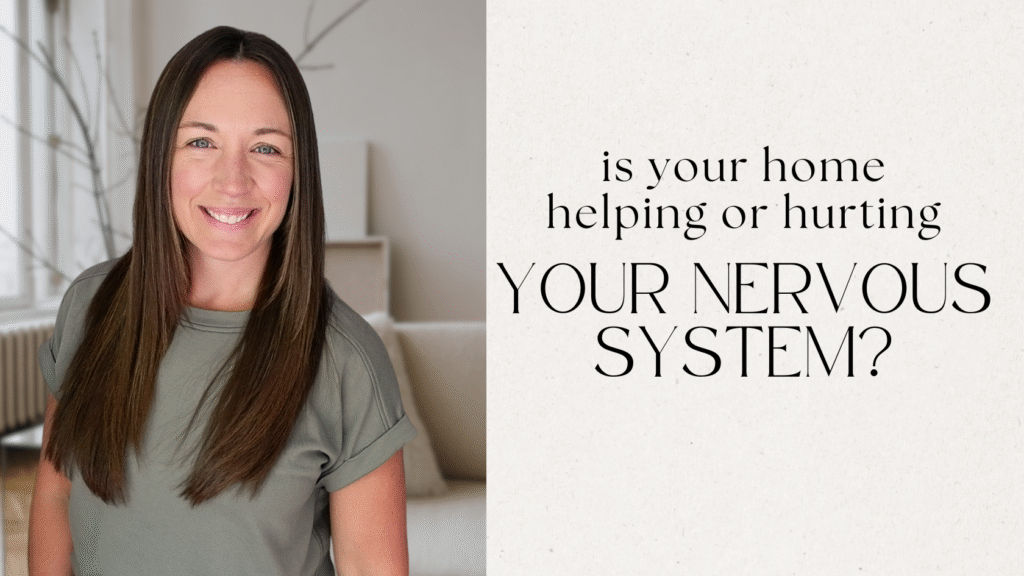
I see it all the time in my work as a Building Biology Practitioner—you’re doing everything “right” for your health, but still feeling overwhelmed, anxious, or physically unwell. Have you considered that your home might be part of what’s keeping your nervous system stuck in that fight-or-flight mode?
When you’re experiencing constant fatigue, heightened sensitivity to everyday stimuli, or find yourself unable to truly relax even in your own space, you might be dealing with nervous system dysregulation. It’s where your body’s stress response system gets stuck in a pattern that doesn’t serve you—and surprisingly, your physical environment plays a huge role in either perpetuating or healing this cycle.
Your Body Knows What You Don't See
Your nervous system is constantly scanning your environment, even when you’re not consciously aware of it. It’s picking up on subtle cues from your surroundings—the artificial blue light from that LED lamp, the low-grade chemical emissions from your new furniture, even the subtle electromagnetic fields from clustered electronics.
Here’s what you might be noticing in your own body:
- You startle easily at sudden noises in your home
- You feel better when you’re away from your house for a few days
- Certain rooms make you feel inexplicably tense
- Your sleep quality varies dramatically without obvious cause
- That brain fog lifts when you spend time outdoors
- You feel more anxious or wired in certain areas of your home
These aren’t coincidences—they’re your body communicating with you about your environment.
The Invisible Stress in Your Space
What troubles me most in my work is seeing how these hidden home toxins directly target your nervous system function. The research is clear on this:
Formaldehyde from your particleboard furniture doesn’t just cause respiratory issues—it’s a neurotoxin that can directly impair brain function by disrupting neurotransmitters. Those scented plugins you use to make your home smell “clean”? The phthalates they contain are endocrine disruptors linked to anxiety and mood disorders by interfering with hormone regulation that affects your brain.
Your mattress or sofa might contain flame retardants (PBDEs) that researchers have found can alter brain development and function. Even residual pesticides tracked in from your yard or garden can trigger nervous system dysfunction by disrupting acetylcholine, a crucial neurotransmitter.
These exposures keep your body in a perpetual state of defense, making it nearly impossible for your nervous system to shift into its rest-and-digest mode—the state where true healing happens.
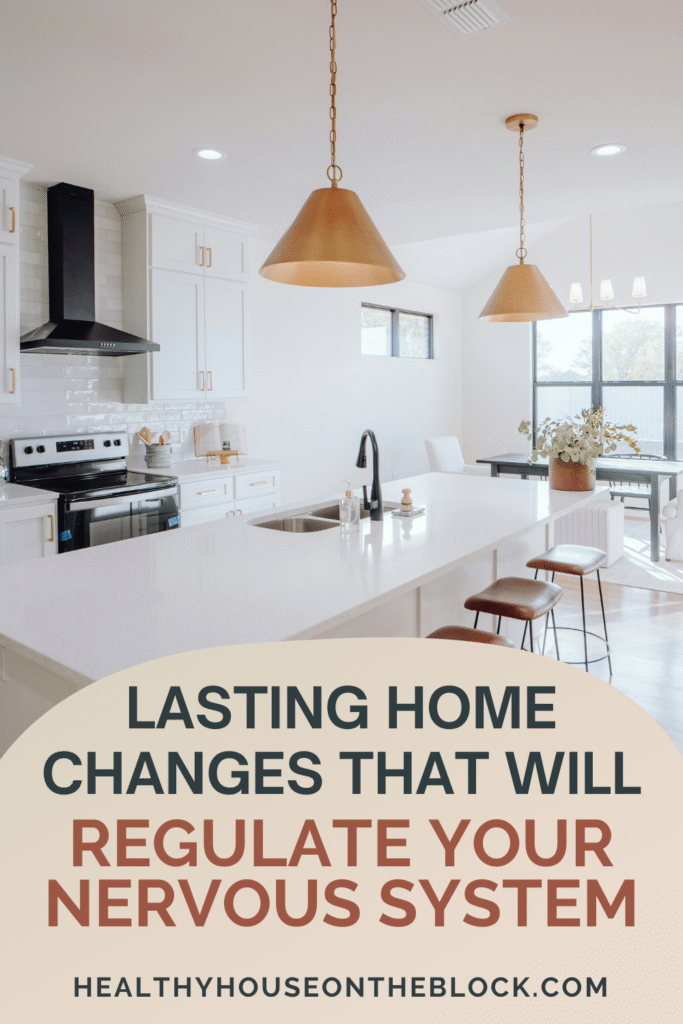
The Hidden Impact of EMFs on Your Nervous System
Let’s talk about something that’s affecting you every day but remains largely invisible: electromagnetic fields (EMFs). As a Building Biology Practitioner, I’ve seen firsthand how the growing sea of wireless radiation and electrical fields in our homes can significantly disrupt nervous system function.
Your body is fundamentally electrical. Your nervous system communicates through delicate electrical impulses, and research is revealing how man-made EMFs can interfere with these natural processes. Here’s what’s happening in your home right now:
Your WiFi router is continuously emitting pulsed radiofrequency radiation, 24/7. The smart meter on your home is sending bursts of data throughout the day. Your cellphone, even when not in use, is constantly communicating with nearby towers. And the electrical wiring in your walls creates alternating current (AC) electric fields that radiate into your living spaces.
What I’ve observed in my clients is concerning: EMF exposure often manifests as:
- Difficulty falling asleep or staying asleep
- Unexplained anxiety or heart palpitations
- Headaches that develop after long periods of device use
- Difficulty concentrating or unusual fatigue
- Tingling sensations or subtle nervous system activation
The science backs this up. Studies have shown that EMF exposure can increase stress hormone production, disrupt melatonin synthesis (crucial for sleep and immune function), alter calcium ion channels in cells (affecting neurotransmitter release), and even impact blood-brain barrier permeability.
One particularly important 2019 review published in Environmental Research concluded that radiofrequency EMFs act as a significant stressor to the nervous system, activating voltage-gated calcium channels that can lead to oxidative stress and downstream neurological effects.
For your nervous system to truly heal, creating an electromagnetically quiet space—especially where you sleep—is absolutely essential.
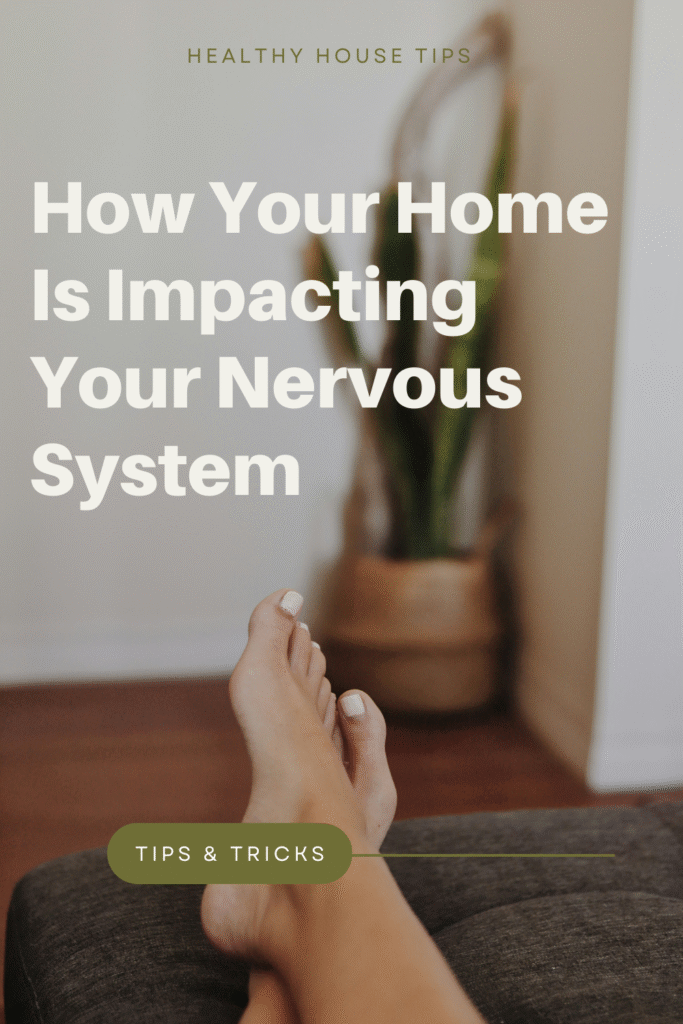
Daily Rituals for Nervous System Regulation
Let me share some practical ways you can immediately start transforming your home into a healing space:
Create a sensory sanctuary in your bedroom. This means dimming lights at least an hour before bed (I recommend warm-toned lamps instead of overhead lighting), removing electronics, and using natural textiles that feel good against your skin. Your nervous system relaxes when it perceives safety through your senses.
Engage your vagus nerve daily. This major nerve is your pathway to calm. Try placing a small tabletop fountain in your living area—the gentle sound of water activates parasympathetic response. Or diffuse small amounts of genuine lavender or chamomile essential oil, which research shows can reduce stress markers in the body.
Connect with the earth through your home. Walk barefoot on untreated wood floors or natural tile. The direct connection with natural materials allows for subtle electrical grounding that studies show can reduce inflammation and stress hormones.
Carve out a low-stimulation corner. Even in a small home, designate a spot with minimal visual clutter, neutral colors, and comfortable seating where you can practice deep breathing or meditation. Your nervous system needs these regular reset moments.
Filter your invisible environment. Invest in a good air purifier with both HEPA and carbon filtration—removing particulates and volatile organic compounds gives your nervous system one less thing to fight against. Similarly, filtering your shower and drinking water removes chlorine byproducts and potential neurotoxins like lead.
Creating an EMF Sanctuary for Your Nervous System
You don’t need to go completely off-grid to give your nervous system relief from electromagnetic stress. Here are practical steps you can take today:
Start with your bedroom. This is where you spend about a third of your life, and it’s when your body does its most important repair work. Create an EMF sanctuary by:
- Removing all wireless devices from your bedroom (no phones, tablets, or wireless alarm clocks)
- Turning off your WiFi router at night (I recommend installing a simple mechanical timer)
- Using battery-powered alarm clocks instead of plug-in versions
- Moving your bed at least 3 feet away from walls with electrical wiring
- Installing a demand switch that cuts power to your bedroom circuit when no electricity is being used
Create distance. EMF intensity decreases dramatically with distance. Keep your router as far from main living spaces as possible. Never keep your cell phone directly on your body—even a few inches of distance significantly reduces exposure to your nervous system.
Use airplane mode strategically. Your nervous system benefits from regular breaks from EMF exposure. Put devices in airplane mode when not actively using their wireless functions, especially when carried in pockets or used by children.
Ground your body. Spending time barefoot outdoors or using grounding mats can help discharge electrical buildup and restore your body’s natural electrical balance. I’ve seen remarkable improvements in sleep quality when clients incorporate grounding into their daily routines.
Hardwire where possible. Replace wireless connections with Ethernet cables for computers and smart TVs. Not only will you reduce EMF exposure, but you’ll likely enjoy faster, more reliable connections too.
Consider shielding selectively. For areas where you can’t eliminate exposure (like if you live near cell towers), specialized EMF-shielding paints, fabrics, and window films can create lower-exposure zones in your home. I recommend working with a Building Biology professional to measure before and after installation to ensure effectiveness.
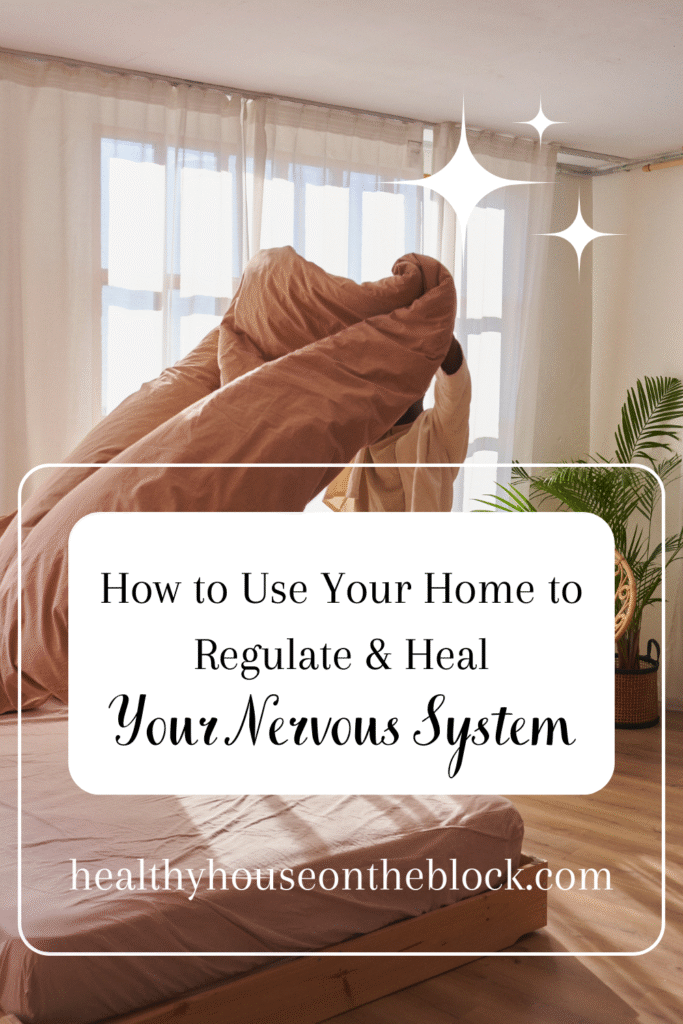
Deeper Home Changes for Lasting Nervous System Health
When you’re ready to make bigger changes, these investments can dramatically shift your home’s impact on your nervous system:
Replace synthetic flooring with natural alternatives. Those vinyl or laminate floors might be emitting chemicals that keep your system on alert. Solid hardwood, ceramic tile, or even natural linoleum made from linseed oil can eliminate these hidden stressors.
Gradually replace foam furniture with healthier options. Conventional sofas and mattresses often contain flame retardants and polyurethane foam that off-gas for years. Look for solid wood frames with natural fiber cushioning like wool, cotton, or natural latex.
Repaint with truly zero-VOC options. Many “low-VOC” paints still contain solvents that can disrupt brain function. I recommend milk paint or clay-based paints that have been used safely for centuries.
Install proper ventilation systems. Fresh air exchange is crucial—mechanical ventilation that brings in filtered outdoor air while removing stale indoor air helps remove the buildup of toxins that can overwhelm your system.
Consider your insulation. If you’re renovating, avoid fiberglass (which contains formaldehyde binders) and opt for sheep’s wool, cellulose, or cork—materials that don’t add to your body’s toxic burden.
Upgrade your electrical system. For the deepest EMF mitigation, consider these more substantial changes:
- Install demand switches in bedrooms and children’s rooms that automatically cut power when no electricity is being used
- Update to properly shielded and grounded electrical wiring during renovations
- Consider a whole-house EMF filter that reduces dirty electricity on your home circuits
- For new construction, incorporate EMF-reducing design elements like metal conduit for wiring and strategic outlet placement
Create a technology plan for your home. Designate certain areas as low-EMF or technology-free zones where your nervous system can fully rest. Consider wired home automation systems instead of wireless smart home features if you’re renovating or building.
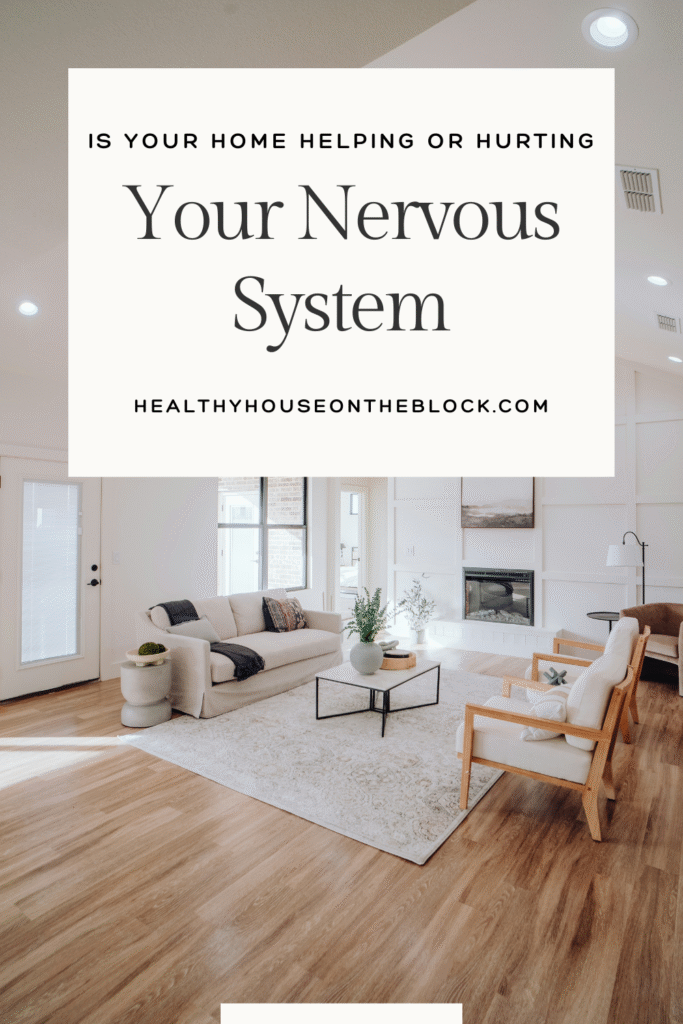
Your Home as Your Healing Partner
The most powerful shift happens when you begin to see your home not just as a place where you live, but as an active participant in your healing journey. When your surroundings send consistent signals of safety to your nervous system, your body can finally relax its vigilance and direct that energy toward repair and regeneration instead.
By addressing both the visible and invisible stressors in your environment—from chemical toxins to electromagnetic radiation—you’re creating a true sanctuary for your nervous system. The cumulative effect of these changes can be profound: many of my clients report improved sleep within days, followed by enhanced mood, clearer thinking, and even resolution of mysterious physical symptoms that conventional approaches couldn’t address.
Remember that this is a journey. Start with your bedroom—the place where you spend the most continuous time—and gradually expand your efforts to other areas of your home. Even small changes can signal to your body that it’s safe to shift from constant vigilance into a state of rest and repair.
Your body knows what it needs—sometimes we just need to listen more closely to what it’s telling us about our environment.

Share this:
- Click to share on Facebook (Opens in new window) Facebook
- Click to share on LinkedIn (Opens in new window) LinkedIn
- Click to share on Reddit (Opens in new window) Reddit
- Click to share on Pinterest (Opens in new window) Pinterest
- Click to print (Opens in new window) Print
- Click to share on X (Opens in new window) X






